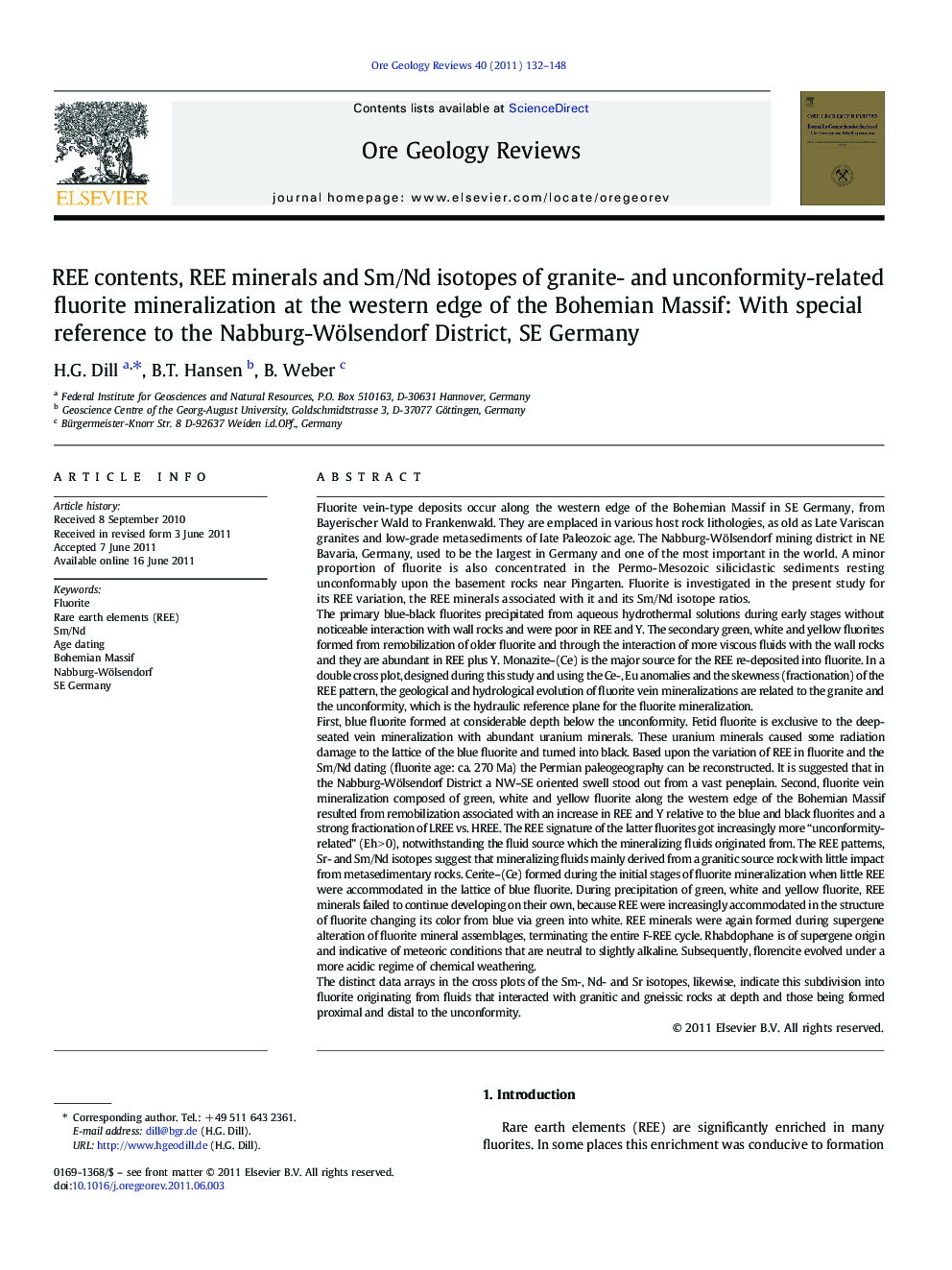| کد مقاله | کد نشریه | سال انتشار | مقاله انگلیسی | نسخه تمام متن |
|---|---|---|---|---|
| 4697725 | 1637260 | 2011 | 17 صفحه PDF | دانلود رایگان |

Fluorite vein-type deposits occur along the western edge of the Bohemian Massif in SE Germany, from Bayerischer Wald to Frankenwald. They are emplaced in various host rock lithologies, as old as Late Variscan granites and low-grade metasediments of late Paleozoic age. The Nabburg-Wölsendorf mining district in NE Bavaria, Germany, used to be the largest in Germany and one of the most important in the world. A minor proportion of fluorite is also concentrated in the Permo-Mesozoic siliciclastic sediments resting unconformably upon the basement rocks near Pingarten. Fluorite is investigated in the present study for its REE variation, the REE minerals associated with it and its Sm/Nd isotope ratios.The primary blue-black fluorites precipitated from aqueous hydrothermal solutions during early stages without noticeable interaction with wall rocks and were poor in REE and Y. The secondary green, white and yellow fluorites formed from remobilization of older fluorite and through the interaction of more viscous fluids with the wall rocks and they are abundant in REE plus Y. Monazite–(Ce) is the major source for the REE re-deposited into fluorite. In a double cross plot, designed during this study and using the Ce-, Eu anomalies and the skewness (fractionation) of the REE pattern, the geological and hydrological evolution of fluorite vein mineralizations are related to the granite and the unconformity, which is the hydraulic reference plane for the fluorite mineralization.First, blue fluorite formed at considerable depth below the unconformity. Fetid fluorite is exclusive to the deep-seated vein mineralization with abundant uranium minerals. These uranium minerals caused some radiation damage to the lattice of the blue fluorite and turned into black. Based upon the variation of REE in fluorite and the Sm/Nd dating (fluorite age: ca. 270 Ma) the Permian paleogeography can be reconstructed. It is suggested that in the Nabburg-Wölsendorf District a NW–SE oriented swell stood out from a vast peneplain. Second, fluorite vein mineralization composed of green, white and yellow fluorite along the western edge of the Bohemian Massif resulted from remobilization associated with an increase in REE and Y relative to the blue and black fluorites and a strong fractionation of LREE vs. HREE. The REE signature of the latter fluorites got increasingly more “unconformity-related” (Eh > 0), notwithstanding the fluid source which the mineralizing fluids originated from. The REE patterns, Sr- and Sm/Nd isotopes suggest that mineralizing fluids mainly derived from a granitic source rock with little impact from metasedimentary rocks. Cerite–(Ce) formed during the initial stages of fluorite mineralization when little REE were accommodated in the lattice of blue fluorite. During precipitation of green, white and yellow fluorite, REE minerals failed to continue developing on their own, because REE were increasingly accommodated in the structure of fluorite changing its color from blue via green into white. REE minerals were again formed during supergene alteration of fluorite mineral assemblages, terminating the entire F-REE cycle. Rhabdophane is of supergene origin and indicative of meteoric conditions that are neutral to slightly alkaline. Subsequently, florencite evolved under a more acidic regime of chemical weathering.The distinct data arrays in the cross plots of the Sm-, Nd- and Sr isotopes, likewise, indicate this subdivision into fluorite originating from fluids that interacted with granitic and gneissic rocks at depth and those being formed proximal and distal to the unconformity.
► We modeled the origin of fluorite deposits based on their REE contents and minerals.
► REE contents are related to the color of fluorite, its origin and age of formation.
► Ce-, Eu anomalies and fractionation of the REE form the basis of a genetic x–y plot.
► Fluorite veins are granite- and unconformity-related (hydraulic reference plane).
► Fluorite originated from fluids that interacted with granitic and gneissic rocks.
Journal: Ore Geology Reviews - Volume 40, Issue 1, September 2011, Pages 132–148